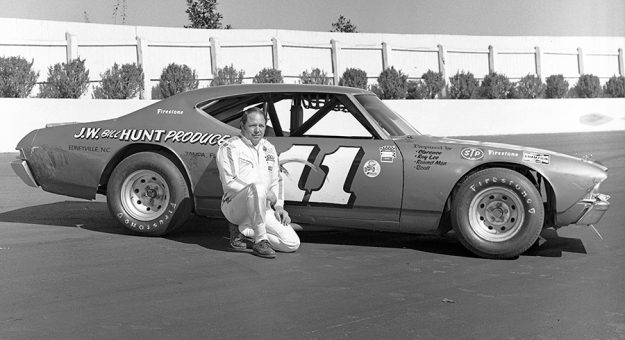INDIANAPOLIS — Nothing came easy for Jack Ingram.
Everything was a struggle, from the moment he arrived in the winter of 1936. It was three days after Christmas in the family home in rural Arden, N.C., at the edge of the Great Smoky Mountains.
“They had to call for the doctor because I was breach-born,” Ingram said. “Come out feet first. Almost died.”
His timing was lousy. Arden sat in a poor corner of a poor state in a country trying to crawl out of the Great Depression. Mother Ingram was a schoolteacher, her husband a carpenter, so there was food on the table.
But there were nine kids, so the notion of extra money was an illusion. When 14-year-old Jack learned about the stock car races at Asheville-Weaverville Speedway, he knew better than to pester his parents about going. He and a pal bicycled there, 25 miles, “and walked around until we found a spot to sneak under the fence. I watched those cars go around, and I loved it.”
That humble beginning produced a legend. When he died on June 25, at age 84, his place as one of America’s best short-track racers was secure.
But early on, there was the small matter of survival. The dawn of the ’50s found his corner of North Carolina still “highly depressed,” but friends who’d been to Washington, D.C., talked of abundant jobs there. So, at 16, that’s where Ingram headed. He worked as a plumber and pipefitter, earning $5.50 an hour “when around Asheville you couldn’t make 75 cents.”
He stayed in Washington nine years, squirreling away every spare dollar for the modified coupe he started building once he got back home. In it, Ingram spent 1963 “wrecking and spinning out” at dirt tracks around the Carolinas. He switched to pavement and instantly felt more comfortable.
But things really came together after a fellow approached him in the pits and said, “Boy, if you’d just quit trying to drive that car so fast, you’d do fine.”
Smiling at the memory, Ingram said, “This man had won a lot of races and everybody admired him, so I listened. It was Ralph Earnhardt.”
He spent the rest of the ’60s honing his chops, winning now and then and building toward a decade he helped define.
During the 1970s, every NASCAR late model sportsman event counted toward the division title, from Daytona’s Permatex 300 to a weekly feature at some bullring. Chasing points meant living on caffeine and truck-stop food. Ingram’s home tracks were Asheville and Hickory Motor Speedway, but he made regular raids into Georgia, Tennessee, South Carolina, Virginia and Maryland.
For three straight years, 1972-’74, he outraced all comers, earning a trio of NASCAR national championships and a nickname that stuck — Ironman.
He beat everybody who was anybody: Harry Gant, Morgan Shepherd, Ray Hendrick, Butch Lindley, Tommy Ellis, Sam Ard, Tommy Houston, Bob Pressley, Gene Glover and more.
Occasionally, tempers flared. After Sonny Hutchins knocked him out of the lead at Martinsville (Va.) Speedway, Ingram hooked the Hutchins car into a hard meeting with the concrete wall.
Shaken, Hutchins was slow exiting his mangled Chevy. He confronted Ingram, mentioned an upcoming race, and said, “I’ll be there, and I’m going to hurt you.”
Ingram replied, “Sonny, it took you five minutes to climb out of that car today. If you mess with me again, they’ll take you home in a pine box.”
Other relationships were downright collegial. Ingram, Gant and Lindley even discussed their travel plans. “There was no need for us all to show up in the same place,” said Jack, “because, well, ain’t but one of us could win.”
His championship streak ended in 1975, but it was a great year anyway, “because I won the Permatex 300. When I drove down pit road toward victory lane, I could not believe I had won Daytona. It was a warm day, but it felt like somebody had turned on all the air conditioners in the world.”
But Ingram’s “favorite victory” came at a less glamorous place, on a Sunday in July of ’78 when a real air conditioner would have come in handy. Enticed by a terrific purse, Ingram hauled to an open-competition race at Alabama’s Birmingham Int’l Raceway, knowing his NASCAR-legal Nova was disadvantaged. Billy Hess, then a part-time driver who worked as a fabricator for Banjo Matthews in Asheville, accompanied Ingram.
“That morning in Birmingham,” said Hess, “the (temperature) sign outside the bank was flashing 102 degrees. Everybody else had lightweight, offset Camaros and Mustangs, yet somehow Jack made the race. After 100 laps, they’d lapped him twice. But he was the only man who didn’t need a relief driver. Everybody else climbed out, laid down and got oxygen. Not Jack. He won by four laps.”
The Ironman allowed himself a small gloat: “Beat all those people into the ground. Just wore ’em out.”
The 1982 birth of the NASCAR Xfinity Series trimmed Ingram’s schedule, but did not quench his fire. In its first five seasons, he won 30 times — adding another Daytona trophy to his collection — and in the standings he finished first, second, second, first and third.
He was a lock for the NASCAR Hall of Fame, which inducted him in 2014. He got there the hard way, but he got there.
